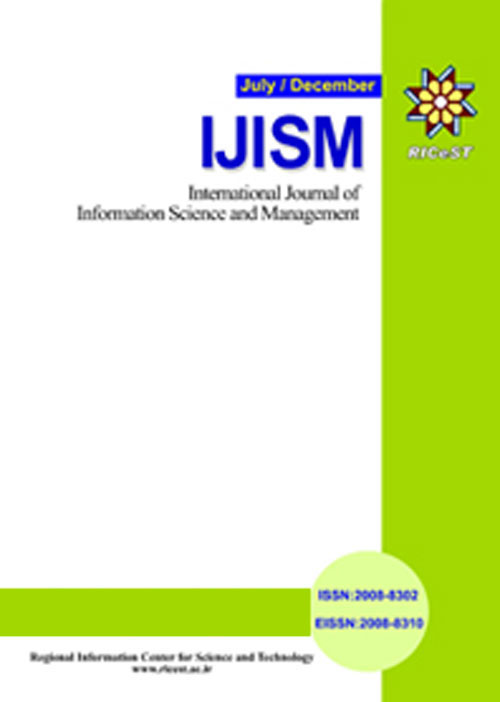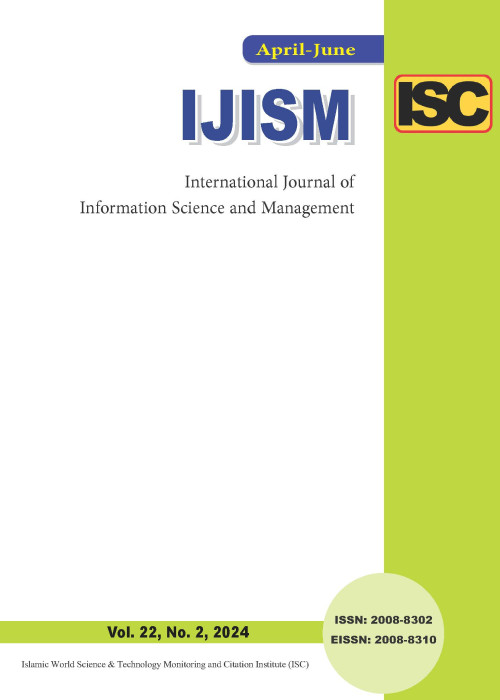فهرست مطالب

International Journal of Information Science and Management
Volume:18 Issue: 1, Jan-Jun 2020
- تاریخ انتشار: 1398/11/26
- تعداد عناوین: 8
-
-
Pages 1-15
Nowadays the amount of textual information on the web is grown rapidly. The huge textual data needs more accurate classification algorithms. Sentiment analysis is a branch of text classification that is used to classify user opinions in case of market decisions, product evaluations or measuring consumer confidence. With the rise of the production rate of Persian text data in a commercial area, improvement of the efficiency of algorithms in Persian is a must. The structure of the Persian language such as word and sentence structures poses some challenges in this area. Deep learning algorithms are recently used in NLP and especially sentiment text classification for many dominant languages like Persian. The goal is to improve the performance of classification using deep learning issues. In this work, the authors proposed a hybrid method by a combination of structural correspondence learning (SCL) and convolutional neural network (CNN). The SCL method selects the most effective pivot features so the adaptation from one domain to similar ones cannot drop the efficiency drastically. The results showed that the proposed hybrid method that is learned from one domain can act efficiently in a similar domain. The result showed that applying a combination of SCL+CNN can improve the result of sentiment classification for two domains more than 10 percent
Keywords: Deep learning, Persian Documents, Sentiment Analysis, Convolutional Neural Network (CNN), Structural Correspondence Learning (SCL) -
Pages 17-24
The hypodermic needle theory is a prominent theory in social media that affects the understanding, attitudes, and behavior of individuals. In this viewpoint, media is a powerful and dangerous source because the user or audience is vulnerable against the effect of a certain message. In this study, we assess the relationship between this theory in the field of information technology with two person-centered approaches of constructionist or discourse analytic approach and the critical theory approach. Moreover, the libraries’ role in vaccinating users against this theory by increasing their knowledge is shown
Keywords: Hypodermic Needle Theory, Social media, Media Literacy, Library -
Pages 25-33
This paper aims to introduce the quantitative method named Reference Publication Year Spectroscopy (RPYS). With this method one can determine the historical roots of research fields and quantify their impact on current research. Using a quantitative method named reference publication year spectroscopy (RPYS), this research tried to determine the historical roots of information seeking behavior research. RPYS pave the way for determining the significant years and works in information seeking behavior. The main problem is it can reveal whether Information Seeking Behavior has the same or different impact on these journals in terms of citation. Using scientometrics method, the initial data of this study have been extracted based on ISC Database. The revised data were analyzed and visualized in Excel. The distribution of cited references in information seeking behavior revealed four peaks within 20th century. Moreover, our analysis identified 4 peaks between 1989 and 2000 in the field of information seeking behavior, occurred respectively in 1989, 1993, 1998, and 2000. Based on the study findings, it seems that information seeking behavior research has been shaped intellectually by fields such as library and information science, management, etc. Moreover, it has been influenced by some theories and theoretical works.
Keywords: Reference Publication Year Spectroscopy, RPYS, Information Seeking Behavior, Information Behavior, Scientometrics, Islamic World Science Citation Center, ISC -
Pages 35-48
The purpose of this study was to investigate the subject of “public libraries” in the Clarivate Analytics Web of Science (WoS) and Islamic World Science Citation Center (ISC). The present study is a descriptive-analytical research adopting scientometrics approach in terms of data collection. The statistical population of the study consisted of 3122 documents indexed in the WoS during 1900-2019 as well as 232 documents indexed in the ISC during 1999-2017. To collect data, we refined the search to title as (TI=Public Library*) and limited it to the time span (PY=19002019) in WoS in order to avoid diversity in the retrieved documents. The same approach was followed to retrieve documents from ISC databases. Research findings showed that foreign researchers were interested in “information science and library”, “computer sciences”, and “architecture” in relation to public library studies. On the other hand, Iranian researchers focused on “public library studies”, “assessment”, and “staff studies including managers and librarians”. Considering the journals publishing research on public library issues, the findings showed that the American Library Journal (n=749) and the Iranian Research on Information Science and public libraries (n=134) published the largest number of articles on the subject at the global and local levels, respectively. USA, Canada, and England were the most productive countries in “public libraries” research area. Besides, University of Illinois and Islamic Azad University were the most active institutions publishing in this field at international and national levels with 62 and 57 documents, respectively. This study aimed to survey and compare research on public libraries in WoS and ISC. An examination of the subject area of public libraries revealed the trends of research fronts at the global level and in Iran and determines whether or not the topics of interest to world-class researchers are close to that of national researchers or if domestic researchers have addressed public library issues with an indigenous approach
Keywords: Public library, WoS, Islamic World Science Citation Center, ISC, Scientometrics -
Pages 49-64
Information literacy is a set of capabilities that requires individuals to know when they need information and the ability to locate, evaluate and effectively use the information they need. Informational literacy in the true sense can contribute to the empowerment of researchers in different academic fields. This research has been conducted to investigate the status of information literacy skills of the faculty members of Amin University. A survey method used to collecting data. The research population includes all the faculty members of Amin University. The data were collected through the American Information Literacy Questionnaire and a researcher-made questionnaire. The results showed that, in terms of "identifying information needs" with an average of 3.37, "effective and efficient access to information" with an average of 3.70, "evaluation of information and information channels" with an average of 3.18, "the effective use of information" with an average of 3.69, "observance of legal issues of information and citation practices" with an average of 3.94 are relatively favorable. In general, the information literacy of subjects under study was evaluated as higher than the optimal level with a mean percentage of 74.32 and a mean score of 3.71 out of 4. Therefore, it can be concluded that by presenting educational and research workshops, the inclusion of an information literacy course (theoretical and practical) at the top of the standards of skills and training of faculty members of the university, a great step would be taken in improving their information literacy
Keywords: Literacy, Information Literacy, Information Need, Information Access, Information Evaluation, Information Channels, Information Use, Information Legal Issues, Referencing Styles, Amin University -
Pages 65-72
The purpose of the study was to articulate the Librarians' Individual Abilities affecting on applying the social networks, as a tool for marketing, from viewpoint of librarians working at the Iranian state university libraries. This research was analytical survey research. The research community consisted of 146 librarians who are working at central libraries of 40 state universities in the capital of province affiliated to Ministry of Science, Research and Technology. Data collection instrument was a researcher- made questionnaire. The findings of the research confirmed the impact of librarians’ individual abilities on the usage of social networks as a marketing tool in academic libraries. Among the components, “skill for establishing a communication via a social networks” (3.34), “familiarity with social network” (3.26) and “cognitive skill for meeting users’ information requirements” (3.13) had the greatest impact on using social networks as a marketing tool in academic libraries. Based on the findings of the research and outputs, we concluded that, individual abilities are among the most important success factors of academic libraries and most be defined as an important element of academic librarians’ competency profile. For that, library managers and librarians are to be aware of the ever-changing conditions in academic libraries, and assess the strengths and weaknesses of individual librarians' characteristics and their job performance for effective use of social networks in library marketing.
Keywords: Iran State University Libraries, Librarians' Individual Abilities, Marketing, Social Networks -
Pages 73-91
To achieve a sustainable development, each country requires a defined interaction between universities, government and industry. The economic, social and cultural development plans in Iran has emphasized on “accountability of scientific, research and educational centers for social, cultural and industrial demands”. This is obvious also in the field of veterinary science. Also, the collaborations of colleges, organizations and industries in this field can contribute to enhance productivity, providing food security and achieving the goals of the resistance economy. Accordingly, using Triple Helix method, the present research investigates the status of university, government and industry interactions in scientific production of Iranians in the field of veterinary science during 2010-2018. The research population was scientific papers of veterinary science research area, indexed in Islamic World Science Citation Center (ISC) or Web of Science database (WOS) by at least one Iranian author during 2010 - 2018. Also, the interactions between UGI were calculated, using ISI.EXE for coding the affiliations and Shannon’s information theory formulas. The results of the study showed that a very small percentage of articles published in veterinary science are written by non-university researchers or even by co-authorship of university and other sectors of the triple helix. Among bilateral relations, the UG interactions had the highest value. The best years for UGI interactions, were the year 2016 and 2013 for ISC articles and 2010 and 2011 for WOS articles. The results also, showed considering the scientific articles published in internal journals (ISC) have a high positive impact on the T-value of UGI interactions, as ISC trilateral interactions are remarkably better than WOS articles
Keywords: Veterinary Science, Triple helix, industry, university, government, co-authorship -
Pages 93-108
Semantic role labeling is the task of attaching semantic tags to the words according to the event represented by the sentence. Persian semantic role labeling is a challenging task and most methods proposed so far depend on a huge number of manually extracted features and are applied on feature engineering to attain high performance. On the other hand, considering the Free-Word-Order and Subject-Object-Verb-Order characteristics of Persian, the arguments of the verbal predicate are often distant and create long-range dependencies. The long-range dependencies can hardly be modeled by these methods. Our goal is to achieve a better performance only with minimal feature engineering and also to capture long-range dependencies in a sentence. To these ends, in this paper a deep model for semantic role labeling is developed with the help of dependency tree for Persian. In our proposed method, for each verbal predicate, the potential arguments are identified by dependency relations, and then the dependency path for each pair of predicate and its candidate argument is embedded using the information in the dependency trees. In the next step, we employed a bi-directional recurrent neural network with long short-term memory units to transform word features into semantic role scores. Experiments have been done on the First Semantic Role Corpus in Persian Language and the corpus provided by the authors. The achieved Macro-average F1-measure is 80.01 for the first corpus and 82.48 for the second one
Keywords: Semantic Role Labeling, Full-Syntactic Parsing, Shallow Syntactic Parsing, Dependency Tree, Phrase-structure Tree, Persian language


